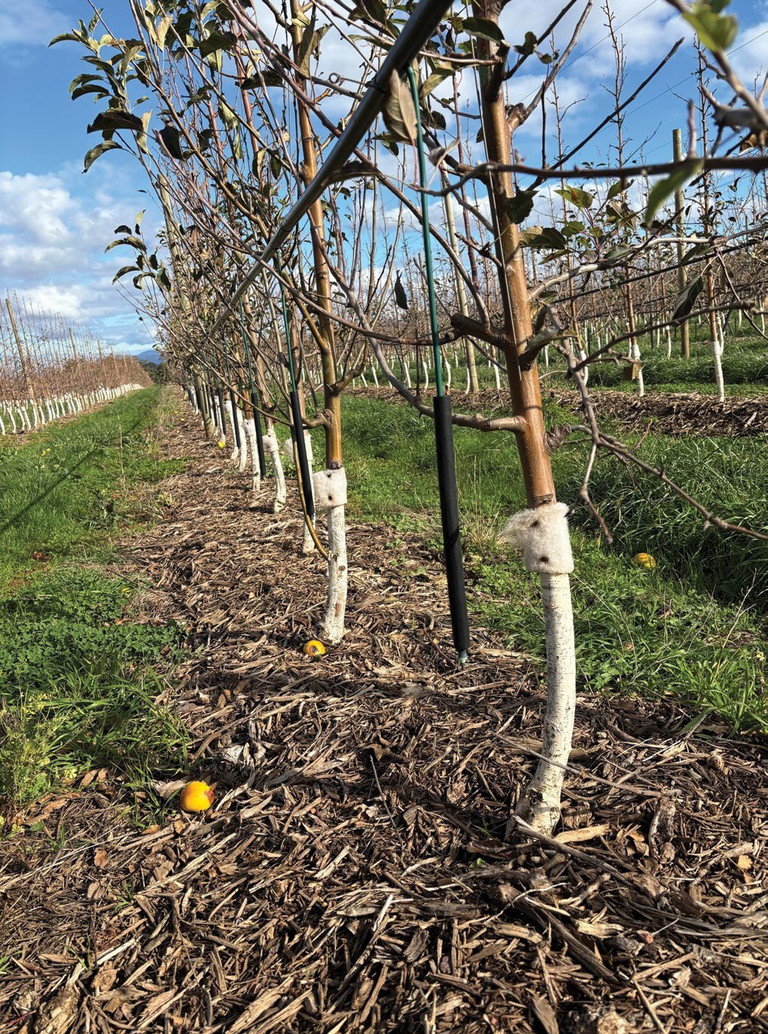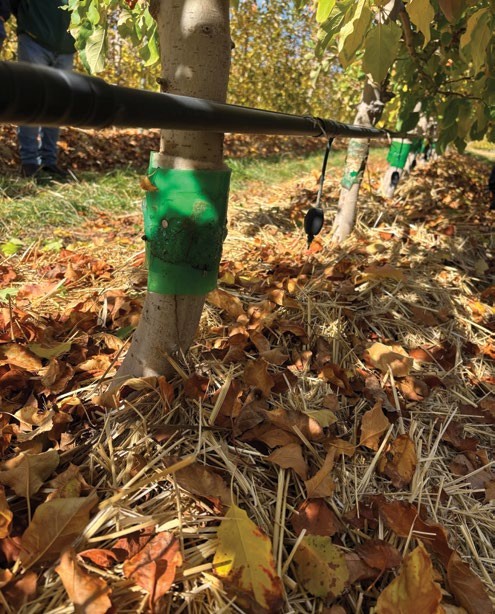POMEWEST innovation

Woody mulch with weevil bands at Fruitways Farm.
SOUTH AFRICA’S ORCHARD INNOVATION:
lessons from the Cape
In June, I joined the APAL Hort Frontiers study tour to South Africa, accompanied by 21 fellow Australian and International growers and industry professionals. Over the course of the tour, we explored a diverse range of orchards, a nursery, and a packhouse gaining valuable insights into the scale, strategy, and sustainability of South African horticulture.
Words Susie Murphy White, Project Manager, Pomewest
THE tour spanned three key growing regions of the Western Cape: Elgin, Grabouw, Vyeboom and Villiersdorp (EGVV), Langkloof, and Koue Bokkeveld. Each region offered unique insights into orchard design, climate adaptation, and market strategy.
With growers present from the United Kingdom, Türkiye, Mexico, India, and New Zealand, the tour was also a rich opportunity for global exchange of ideas and experiences.
Industry overview: scale, export, and market reach
At the start of the tour, Hortgro, South Africa’s peak grower and industry R&D body, provided a comprehensive overview of the country’s pome and stone fruit industry. The sector comprises 1,155 growers, producing 2.1 million tonnes of fruit annually from 54,271 hectares, with an average yield of 40 tonnes per hectare.
The varieties grown include many of the same ones grown here: Royal Gala, Pink Lady, Top Red (Red Delicious), Fuji, Cripps Red, Kanzi, Golden Delicious, and Granny Smith. Forty per cent of the fresh apples are exported to 86 countries, including Far East Asia, the Middle East, Africa, the UK, and Russia. Every apple has a market, with juice fruit proving profitable for growers, although quality drives higher profits.
This high export volume places pressure on growers to meet tightening international regulations around chemical usage and customer expectations, driving innovation in orchard management and sustainability.
South African growers demonstrated a clear understanding of their market positioning, growing for quantity to meet lower-tier markets or focusing on quality for premium destinations. This strategic approach influences everything from cultivar selection to harvest timing and post-harvest handling.
Adapting to a changing climate
One of the standout learnings was the influence of climate on basal dominance, poor terminal growth, and bare wood, which contributes to mixed maturity within trees. Managing this physiological challenge is key to achieving uniform fruit development and harvest.

Barley straw mulch with weevil bands using an attractant at Dutoit farms.
In low-chill environments, the use of dormancy breakers is essential to synchronise bud break and maintain productivity. These tools are critical in regions where traditional winter chill is insufficient for temperate fruit trees.
Soil health and regenerative practices
The tour also highlighted the growing emphasis on regenerative agriculture. At several properties, we saw the use of woody mulches and barley straw on the ‘berm’ (in the treeline). A green living mulch and cover crops had been trialled in the north. It was interesting to see that where mulch had been used, every tree had a weevil band. Initially, weevils had been a problem; this has been addressed with the use of weevil bands.
These practices are delivering tangible gains in soil health and orchard productivity, reinforcing the importance of working with nature. They were also used to improve water conservation and reduce the effects of extreme heat.
Innovation in propagation
Another highlight was the use of tissue culture and green grafting to produce high-quality trees at Cape Sweet Nursery. These propagation techniques are helping South African growers establish orchards with uniform, vigorous, and disease-free planting material, setting a strong foundation for long-term success.
“The scale of the South African operations was impressive and their ability to market all fruit picked from trees.”
Ann Lyster
South Africa’s horticultural sector is a compelling blend of scale, innovation, and adaptability. Whether it was the regenerative practices or the precision of export-focused operations, the tour offered a wealth of inspiration.